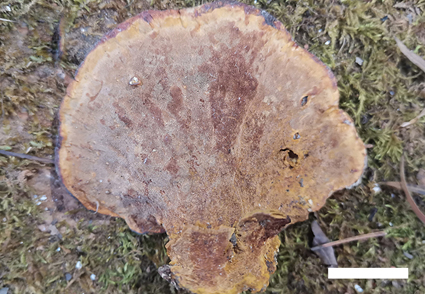Abstract
A new wood-inhabiting fungal species, Fulvoderma yunnanense , is proposed based on a combination of morphological features and molecular data . Fulvoderma yunnanense is characterized by annual, laterally stipitate basidiomata with greyish brown pore surface , a monomitic hyphal system with simple septate generative hyphae , tubular cystidia and broad ellipsoid to subglobose , thin-walled, smooth basidiospores measuring as 4.0– 5.4 × 3.3– 4.8 µm . Sequences of ITS and nLSU rRNA gene regions of the specimens were generated, and phylogenetic analyses were carried out with methods of maximum parsimony, maximum likelihood, and Bayesian inference. The phylogenetic analyses inferred from ITS+nLSU indicated that F. yunnanense nested in Fulvoderma within Hymenochaetaceae. Furthermore, the phylogenetic analysis based on the ITS dataset revealed that the new species formed a well-supported monophyletic lineage with F. australe. Full description, photo plates and a phylogenetic tree to show the placement of the new species are given.
References
- Bernicchia, A. & Gorjón, S.P. (2010) Fungi Europaei 12: Corticiaceae s.l.. Edizioni Candusso, Lomazzo, pp. 1–1007.
- Cai, J., Zou, L., Wu, X. & Zhao, C.L. (2023) Physisporinus yunnanensis sp. nov. (Polyporales, Basidiomycota) from Southern China. Phytotaxa 579: 98‒106. https://doi.org/10.11646/phytotaxa.579.2.3
- Dai, Y.C. (2010) Hymenochaetaceae (Basidiomycota) in China. Fungal diversity 45: 131–343. https://doi.org/10.1007/s13225-010-0066-9
- Dai, Y.C. (201 2) Polypore diversity in China with an annotated checklist of Chinese polypores. Mycoscience 53: 49–80 . https://doi.org/10.1007/s10267-011-0134-3
- Dai, Y.C., Cui, B.K., Si, J., He, S.H., Hyde, K.D. & Zhou, L.W. (2015) Dynamics of the worldwide number of fungi with emphasison fungal diversity in China. Mycological Progress 14: 62–9. https://doi.org/ 10.1007/s11557-015-1084-5
- Dai, Y.C., Yang, Z.L., Cui, B.K., Wu, G., Yuan, H.S., Zhou, L.W., He, S.H., Ge, Z.W., Wu, F., Wei, Y.L., Yuan, Y. & Si, J. (2021) Diversity and systematics of the important macrofungi in Chinese forests . Mycosystema 40: 770 ‒ 805. https://doi.org/ 10.13346/j.mycosystema.210036
- Duan, Z.Y., Yang, X. & Zhao, C.L. (2023) Morphological characteristics and phylogenetic analyses revealed two additional taxa in Cyathus (Agaricales, Basidiomycota). Phytotaxa 598 (1): 1–20. https://doi.org/10.11646/phytotaxa.598.1.1
- Felsenstein, J. (1985) Confidence intervals on phylogenetics: an approach using bootstrap. Evolution 39: 783 ‒ 791 . https://doi.org/ 10.1111/j.1558-5646.1985.tb00420.x
- Gilbertson, R.L. & Ryvarden, L. (1986) North American polypores. Fungiflora, Oslo.
- Hall, T.A. (1999) BioEdit: a user-friendly biological sequence alignment editor and analysis program for Windows 95/98/NT. Nucleic Acids Symposium Series 41: 95–98.
- Huang, R.X., Luo, K.Y. & Zhao, C.L. (2020) Phlebia nigrodontea sp. nov. in Meruliaceae (Polyporales) with a black hymenial surface. Phytotaxa 458: 195–206. https://doi.org/10.11646/phytotaxa.458.3.2
- Hu, Y., Karunarathna, S.C., Li, H., Galappaththi, M.C., Zhao, C.L., Kakumyan, P. & Mortimer, P.E. (2022) The Impact of Drying Temperature on Basidiospore Size. Diversity 14 (4): 239.
- Lee, H., Park, M.S., Park, J.H., Cho, H.J., Park, K.H., Yoo, S., Lee, J.W., Kim, N.K., Lee, J.S., Park, J.Y., Kim, C., Kim, J.J., Lim, Y.W. (2020) Seventeen Unrecorded Species from Gayasan National Park in Korea. Mycobiology 48: 184–194. https://doi.org/10.1080/12298093.2020.1765719
- Ma, R.X., Shi, Z.J. & Zhao, C.L. (2020) A new species of Efibula (Polyporales, Basidiomycota) from China. Phytotaxa 451: 238–244. https://doi.org/10.11646/phytotaxa.451.3.7
- Martin, M.P., Cruz, R.H., Duenas, M., Baseia, I.G. & Telleria, M.T. (2015) Cyathus lignilantanae sp. nov., a new species of bird’s nest fungi (Basidiomycota) from Cape Verde Archipelago. Phytotaxa 236 : 161‒172. https://doi.org/10.11646/phytotaxa.236.2.5
- Miller, M.A., Holder, M.T., Vos, R., Midford, P.E., Liebowitz, T., Chan, L., Hoover, P. & Warnow, T. (2009) The CIPRES Portals. CIPRES. Available from: http://www.phylo.org/sub_sections/portal (Accessed 4 Aug. 2009). [Archived by WebCite(r) at http://www.webcitation.org/5imQlJeQa]
- Núñez, M. & Ryvarden, L. (2001) East Asian polypores 1-2. Synopsis Fungorum 14: 1–522.
- Nylander, J.A.A. (2004) MrModeltest v2. Program Distributed by the Author; Evolutionary Biology Centre, Uppsala University: Uppsala, Sweden.
- Pan, R.R. & Zhou, L.W. (2016) Hymenochaete conchata sp. nov. (Hymenochaetaceae, Basidiomycota) from Chiang Mai, Thailand. Phytotaxa 273 (3): 200– 206. https://doi.org/10.11646/phytotaxa.273.3.7
- Petersen, J.H. (1996) Farvekort. The Danish Mycological Society’s colour-chart. Foreningen til Svampekundskabens Fremme, Greve, Germany, pp. 1–6.
- Ronquist, F. & Huelsenbeck, J.P. (2003) MrBayes 3: Bayesian phylogenetic inference under mixed models. Bioinformatics 19: 1572–1574. https://doi.org/10.1093/bioinformatics/btg180
- Ryvarden, L. & Melo, I. (2014) Poroid fungi of Europe. Synopsis Fungorum 31: 1–455.
- Swofford, D.L. (2002) PAUP*: phylogenetic analysis using parsimony (*and other methods) Version 4.0b10. Sinauer Associates: Massachusetts, MA, USA.
- Wang, H., He, X. & Zhao, C.L. (2020) Scytinostroma yunnanense sp. nov. (Russulales, Basidiomycota) evidenced by morphological characteristics and phylogenetic analyses in China. Phytotaxa 451 (2): 145–153. https://doi.org/10.11646/phytotaxa.451.2.4
- Wu, F., Yuan, H.S., Zhou, L.W., Yuan, Y., Cui, B.K. & Dai, Y.C. (2020) Polypore diversity in South China. Mycosystema 39: 653‒682 .
- Zhao, C.L. & Wu, Z.Q. (2017) Ceriporiopsis kunmingensis sp. nov. (Polyporales, Basidiomycota) evidenced by morphological characters and phylogenetic analysis. Mycological Progress 16: 93–100 . https://doi.org/ 10.1007/s11557-016-1259-8
- Zhou, L.W. (2015) Cylindrosporus flavidus gen. et comb. nov. (Hymenochaetales, Basidiomycota) segregated from Onnia. Phytotaxa 219 (3): 276–282. https://doi.org/10.11646/phytotaxa.219.3.7
- Zhou, L.W., Ji, X.H., Vlasák, J. & Dai, Y.C. (2018) Taxonomy and phylogeny of Pyrrhoderma: a redefinition, the segregation of Fulvoderma, gen. nov., and identifying four new species. Mycologia 110: 872–889. https://doi.org/10.1080/00275514.2018.1474326


